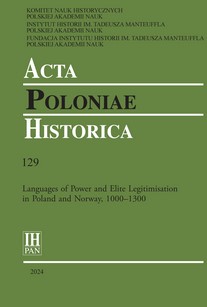TRIMMING THE TANGLE OF LEGEND: HEROIC HAIRCUTS, MATERIALISING MEALS, AND THE LEGITIMISATION OF DYNASTIC SUCCESSION IN NORWEGIAN AND POLISH FOUNDATION NARRATIVES
TRIMMING THE TANGLE OF LEGEND: HEROIC HAIRCUTS, MATERIALISING MEALS, AND THE LEGITIMISATION OF DYNASTIC SUCCESSION IN NORWEGIAN AND POLISH FOUNDATION NARRATIVES
Author(s): Ben Allport, Rafał RutkowskiSubject(s): Cultural history, Customs / Folklore, Comparative history, 13th to 14th Centuries
Published by: Instytut Historii im. Tadeusza Manteuffla Polskiej Akademii Nauk
Keywords: origin legends; medieval historiography; dynastic legends; ritual haircut; feast;
Summary/Abstract: The medieval origin narratives of both Poland and Norway feature dynastic founders who came to power following a ritualistic haircut. In the Polish tradition, Siemowit of the Piast dynasty is anointed duke after his coming-of-age haircut, which is administered by two mysterious strangers; in the Norwegian version, Harald Fairhair vows to only cut his hair after he has united the realm. In both traditions, the transfer of power to these new rulers is also symbolised by a feast that vanishes from the table of a previous ruler and materialises before the dynastic founder. This chapter examines these narratives and compares their use of haircutting and feasting motifs to explore the transmission of royal authority both within and between ruling dynasties. Two traditions are explored from each arena: Gallus Anonymus’s Gesta principum Polonorum and Kadłubek’s Chronica Polonorum from Poland; and Fagrskinna and Snorri Sturluson’s Heimskringla from Norway. In comparing how the haircutting tradition in each polity evolved, we gain profound insights into their authors’ approach towards the development of dynastic power and the structure of dynastic history. In particular, we consider how these authors rationalised the concept of dynastic fragmentation and the rise of rival claimants as these elements came to dominate the political struggles of the twelfth and thirteenth centuries. Broadly speaking, we conclude that Polish historiography sought to cut away rival dynasts, whereas Norwegian traditions visualised competing dynastic branches as locks of hair cascading from one head.
Journal: Acta Poloniae Historica
- Issue Year: 2024
- Issue No: 129
- Page Range: 31-63
- Page Count: 33
- Language: English

